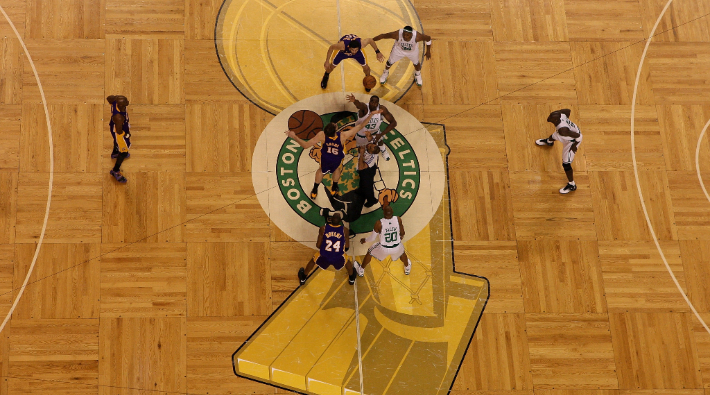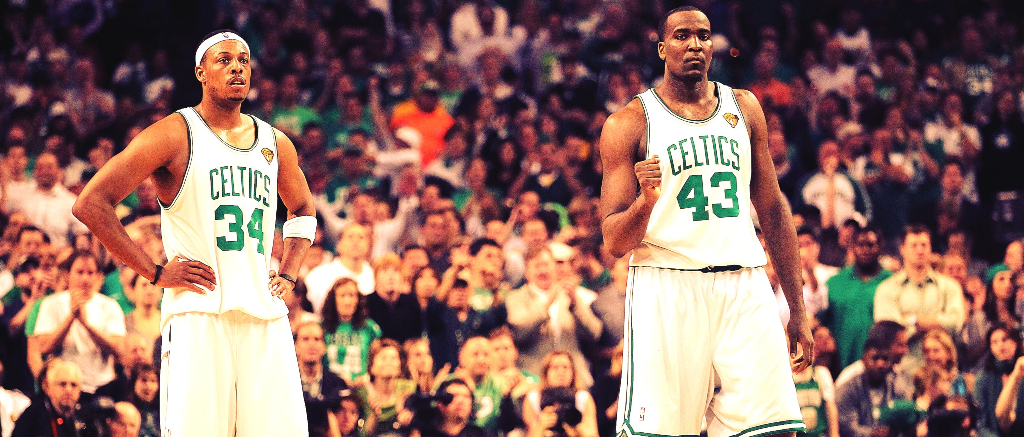Without realizing it, Kendrick Perkins backed up everything he’s just told me about winning, buying into a role, and basketball greatness in one simple story. Dime caught up with Perkins over the phone on the day ESPN, where he’s transitioned into a utility man role since retiring from the NBA, re-aired the 2008 Finals between his Boston Celtics and rival Los Angeles Lakers. The network is also between installments of “The Last Dance,” the documentary series capturing every sports fan’s attention and generating another round of conversation around the 1997-98 Chicago Bulls.
I asked Perkins about his memories of winning the championship in 2008, and his brain jumps to one moment. It’s the start of the second half of Game 4 and the Celtics returned to the floor down 18. Lamar Odom and Pau Gasol had combined for 25 points in the first half. Boston coach Doc Rivers slotted Kevin Garnett in at center to create a mismatch against the Lakers’ big front line, which sparked a torrid Celtics comeback. They’d go on to win the game, 97-91.
Noticeably absent from that strategy? Starting center Kendrick Perkins, who played just two minutes in the second half. He was ready for that possibility, though, because it helped the team experience something “beautiful:” winning a ring.
“Between Doc [Rivers] and Danny [Ainge], I don’t know where I would be without those guys,” Perkins said. “They were always honest with me, they always told me the truth. Not what I wanted to hear, but what I needed to hear. When you have a coach like that and a GM like that, the sky’s the limit.”
1 of the Greatest Comebacks in Finals History!!!! 💉💉🍀🍀🍀 https://t.co/dPtLpzDn6b
— Kendrick Perkins (@KendrickPerkins) April 22, 2020
In “The Last Dance,” we see what happens when a team’s relationship with an executive like Jerry Krause frays. Sometimes, the greatness of individual players like Michael Jordan and Scottie Pippen can help overcome fractured connections, but most of the time, you need buy-in and trust from all parties to be great.
Though Perkins didn’t enter the league until 2004, after Jordan’s third retirement, he got to play with guys like Garnett and Sam Cassell, competed against Jordan and the other great teams of that era.
“When you’re able to be around those types of vets, you get a different feel and a different vibe of how to approach the game,” Perkins said. “You get this mean streak and hard work about yourself, that this is how the league is supposed to be.”
Later in his career, Perkins became one of those veterans, continuing the circuit of mentorship. He was a starter for three-plus years in Oklahoma City, starting every game en route to the Thunder making the Finals in 2012. Later on, he joined as an end-of-bench piece in Cleveland during LeBron James’ second stint with the team. It wasn’t always as smooth a build-up as it was for those Celtics, which won a championship in their first year together.
“It did happen immediately with the Celtics because KG took a back seat and Doc Rivers nipped it in the bud from the jump,” Perkins said. “KG first got to the Celtics and he said this is Paul Pierce’s. It’s his team. I’m going to set screens for Ray Allen, I’m going to do my job and anchor this defense, and this is how we’re going to roll with it if we’re going to be successful doing it.”
This is the process we see play out during “The Last Dance.” NBA teams use the fall to come together, something that is prominently displayed in the second episode of the series: Pippen recovers from surgery, Dennis Rodman pulls it together for long enough to win some games, the coach strikes the right tone, and on and on.
The other thing great teams need are players, like Perkins, who can fill in gaps and be content with not being a superstar. After a while, he admits this to me. Apart from a Robin who’s “OK with being Robin,” role players are the next biggest ingredient on a championship roster. In “The Last Dance,” one such player is Steve Kerr, now the coach of the Warriors.

For Perkins’ Celtics and Thunder teams, he was one of those vital role players, despite coming into the league out of high school as a first-round pick. Those players oftentimes have sky-high expectations, but for Perkins, finding himself in a situation where the weight of the world wasn’t placed on his shoulders was crucial.
“If you come across a great coach like I did with Doc Rivers that instilled in me that it was OK to be who I was as a player and be a star in my role, you can have a long NBA career,” Perkins said.
By Perkins’ estimation, Robert Horry, another “star in his role,” is the best role player of all time, with seven rings to show for it. That’s a tough bar to clear, but the consistency, longevity and sacrifice clearly show a guy who knew what success as a pro would look like for him specifically.
“You need that veteran in your ear, you need the right people in your corner outside of basketball, and you need people that are going to tell you the truth,” Perkins said. “The average NBA career is three to four years, but you could be a Jared Dudley or you could be a Kendrick Perkins and go above that if you can be a star in your role. But you have to be willing to accept it.”
As Perkins adjusts to days doing “Hoop Streams” for ESPN in quarantine, the network has given him an opportunity to revisit and re-evaluate greatness. Players like Perkins can sometimes be forgotten parts of the championship equation, but the psychological work of becoming a “star in your role,” as Perkins describes himself, is at least comparable to the psychological work of a superstar like Jordan that is dissected in “The Last Dance.”
It is less appreciated, and veers in the direction of surrender rather than consumption, but Jordan needed Kerr just like the Celtics or Kevin Durant needed Perkins. They make the whole thing work, even if sometimes their biggest achievements don’t get the attention of the headline-grabbing moments. The greatest achievement of your career might come while you’re on the bench, but if a player can embrace that, they can achieve incredible things.







